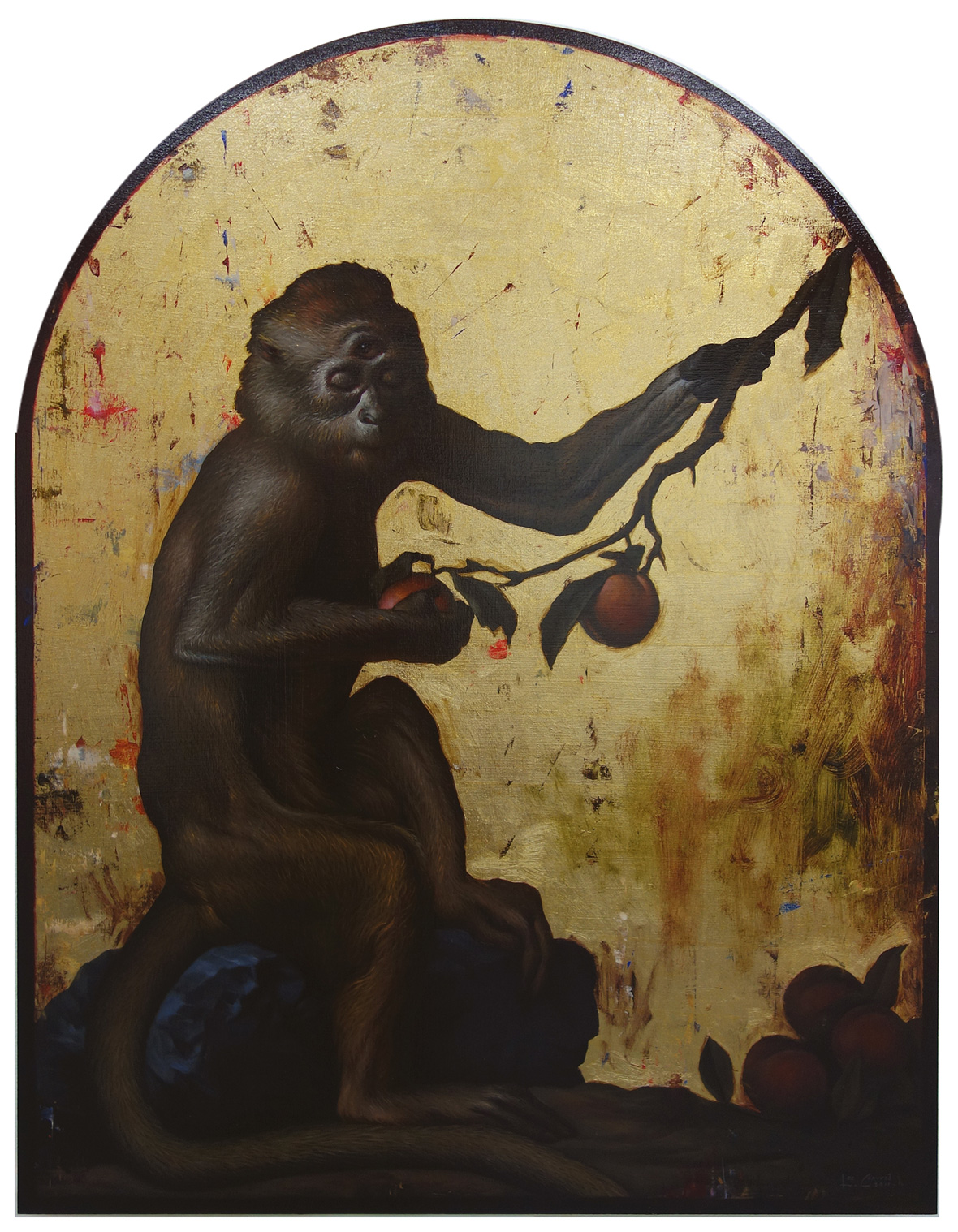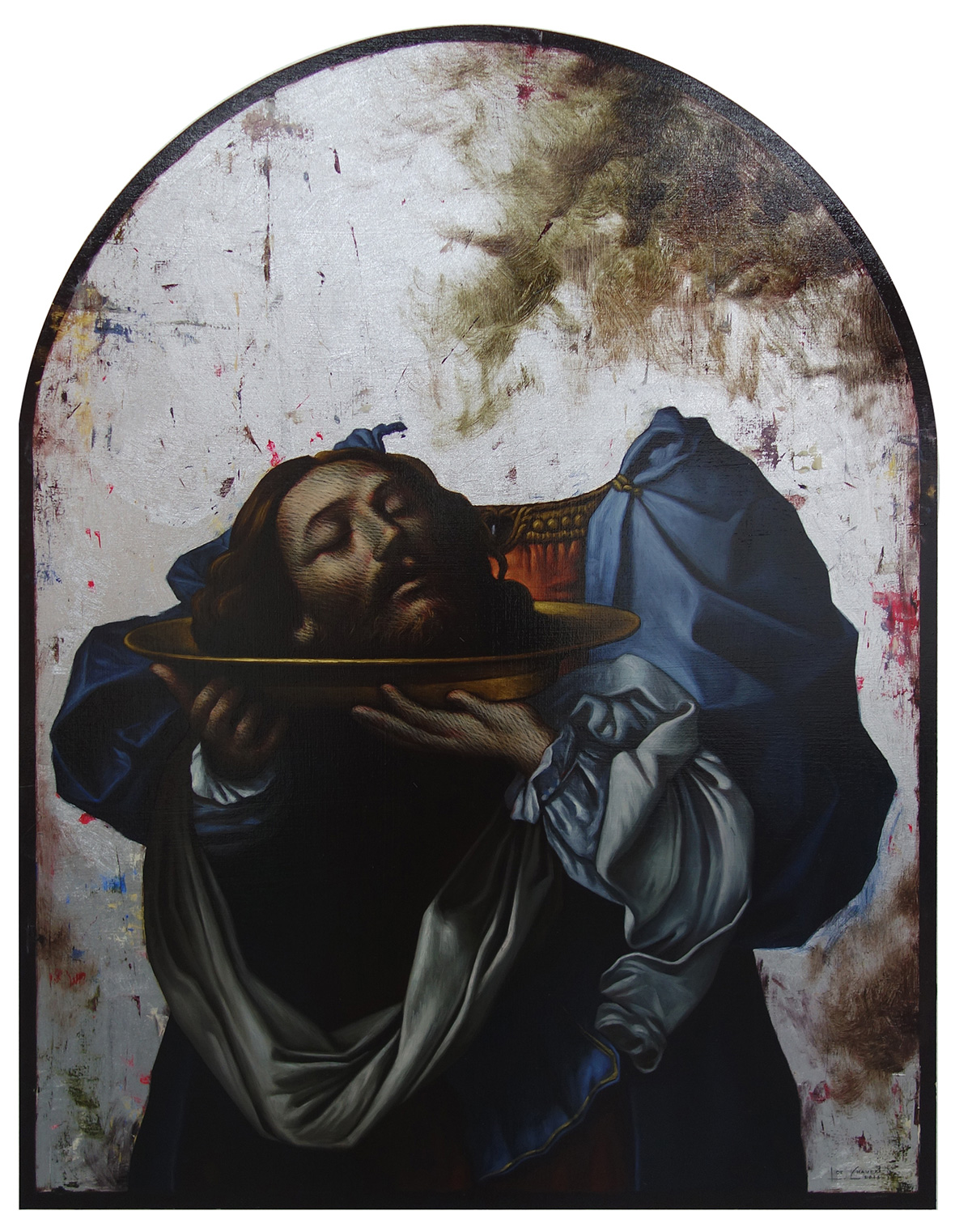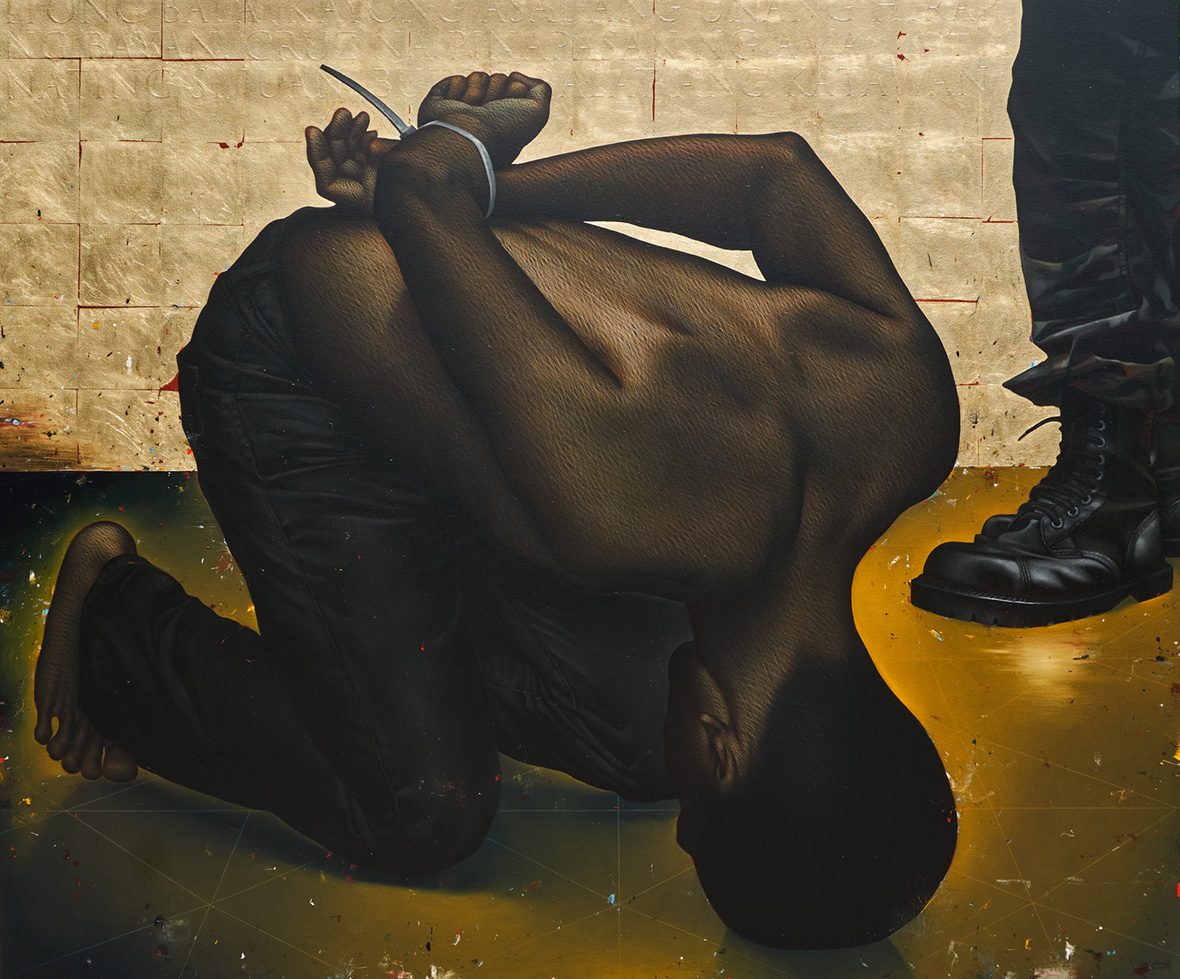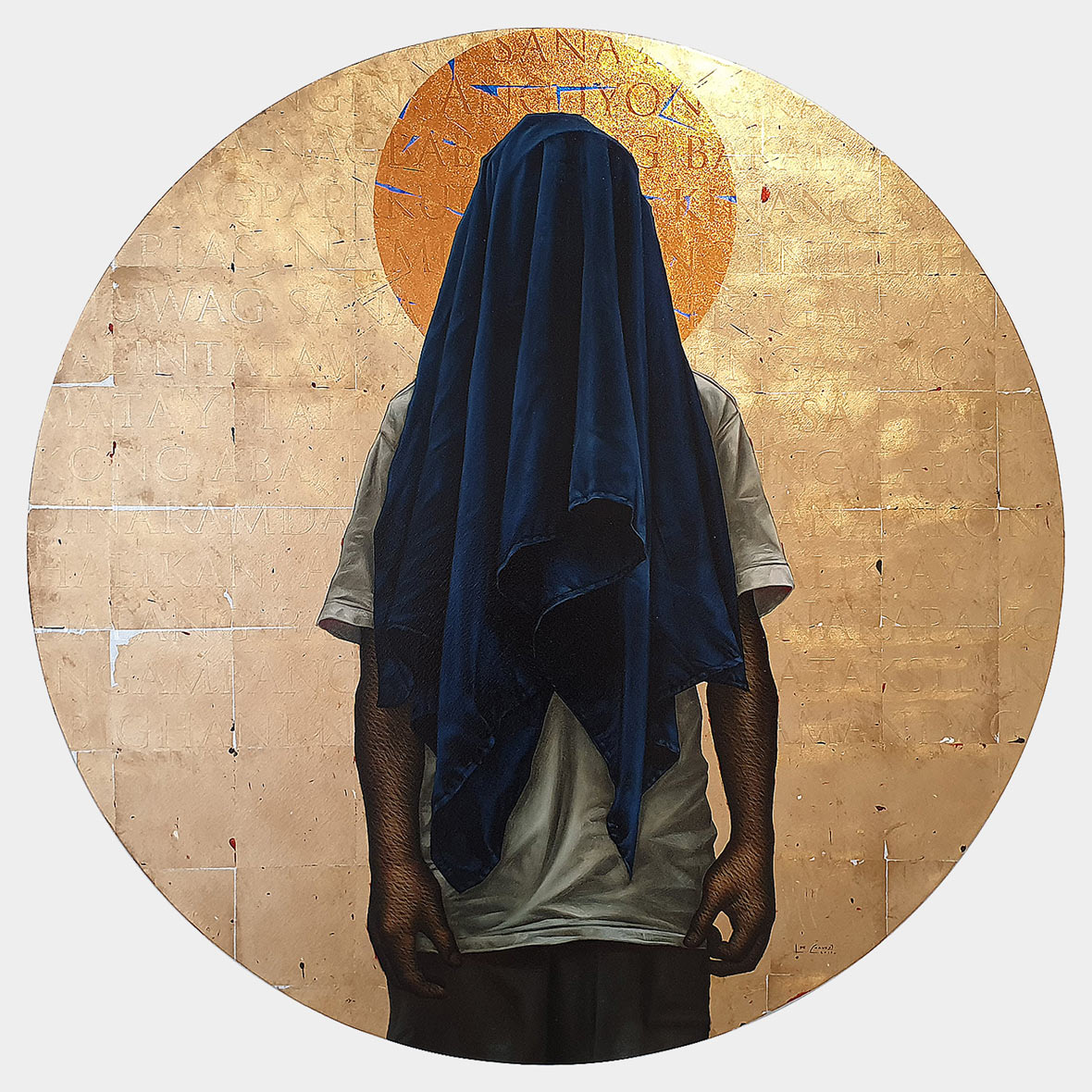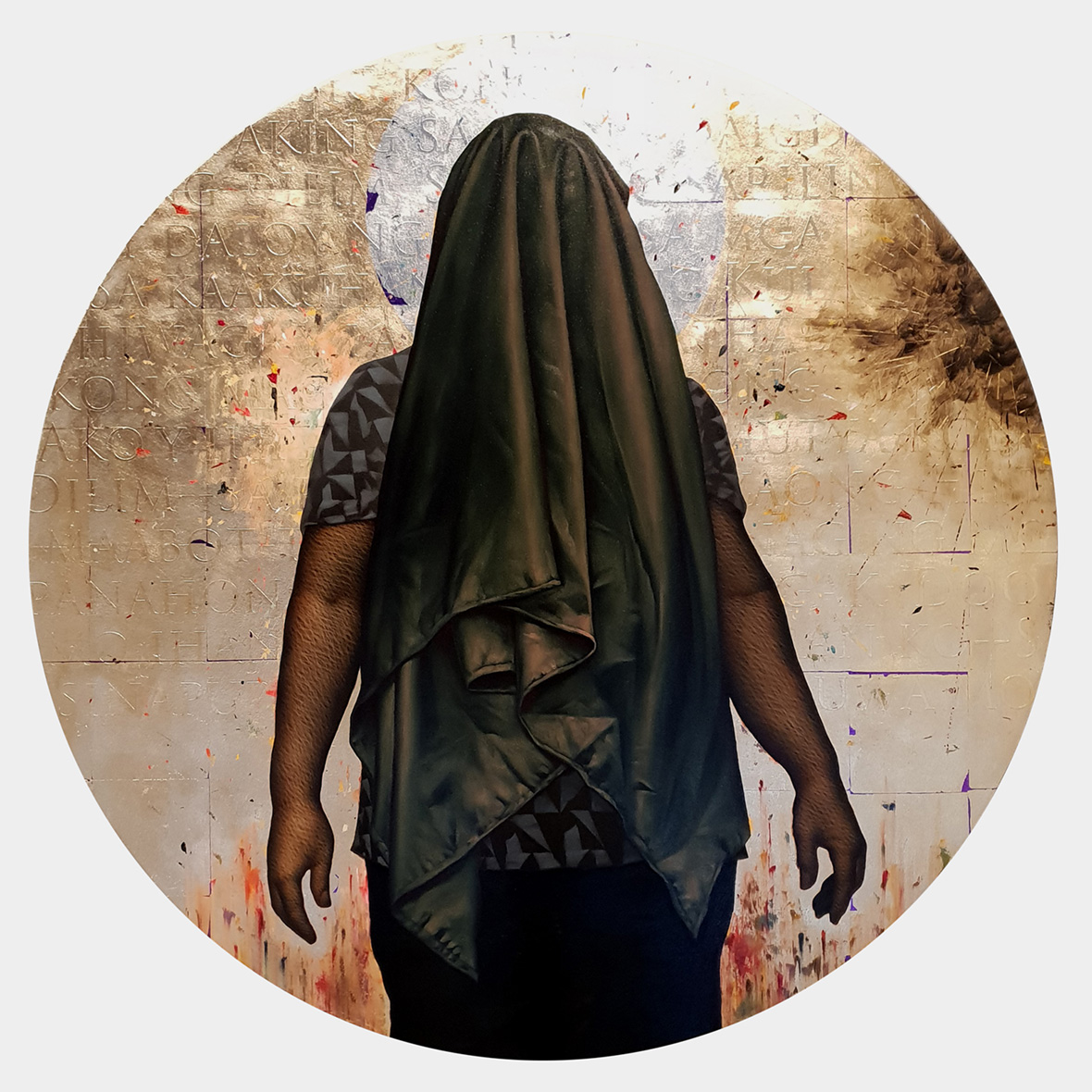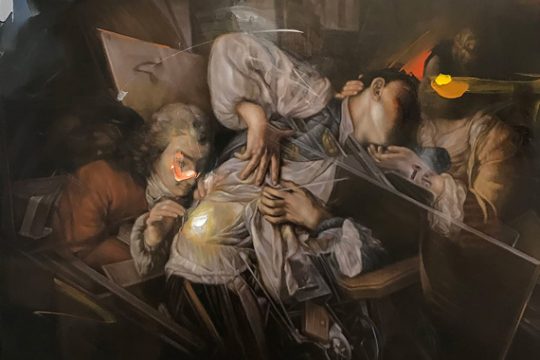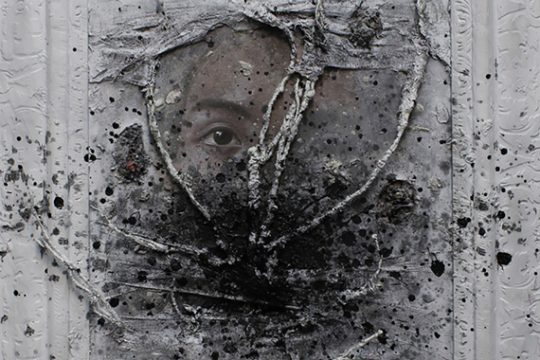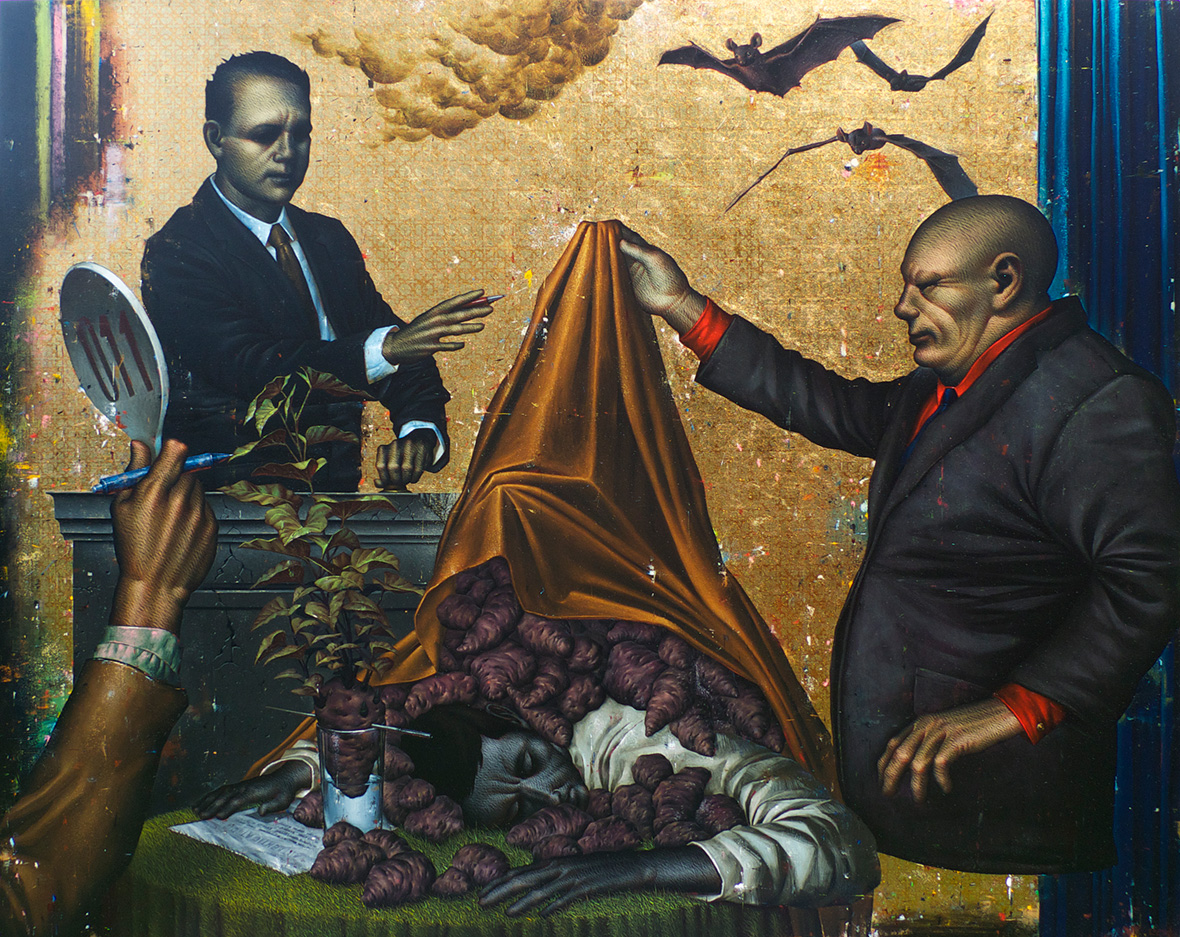
Ornate vestments, consecrated objects, baroque stained glass, towering arches. These beautiful facets of the Catholic church are meant to instill awe in worshipers. It certainly enthralled Leslie de Chavez, who’s been attending Sunday services since childhood. “I’ve always been fascinated by religious art,” the Filipino painter says, and his work is heavily imbued with its influences. But as he grew up, so did his understanding of the church’s role in the colonization of the Philippines and the way its visual culture helped empower them. “Colonizers employed beautiful images and luxurious motifs to propagate Catholic faith and reign over the psyche of our people to support the colonial order. They promoted the idea of beauty as equivalent to holiness.”
华丽的祀服、神圣的祭物、巴洛克式的彩绘玻璃,加之高耸的半圆拱门——这些美轮美奂的天主教堂元素,旨在激发敬拜者的敬畏之心,也深深吸引着从小就参加周日礼拜的 Leslie de Chavez。这位菲律宾画家说:“宗教艺术总是让我特别着迷。”而这对他的艺术创作也有着深远影响。然而,长大后的他渐渐意识到教会对菲律宾人们的殖民化作用,以及其视觉文化所带给人们的力量。“殖民者用华丽的形象和图案来传播天主教信仰,以此掌控人们的精神,从而支持殖民统治。他们将美与神圣联系起来。”
The gilding methods, glazing techniques and arch-shaped canvases prevalent in de Chavez’s work all point back to Catholic aesthetics. Using these familiar elements, he aims to start a discourse around the contemporary manifestations of the Philippines’ colonization: “Just like how religion utilized art to propagate the Catholic faith, I use these motifs in my paintings to tackle issues affecting our people.”
de Chavez grew up with devoutly religious parents who ran a bicycle shop. Although they weren’t artists, they supported him in his creative endeavors. “They saw to it that we were able to pursue our dreams, despite the contradictions it might incur to their beliefs and wishes,” he says. “They always try to understand the things I do and learn from them.”
At 42 years old, de Chavez continues to attend services with his children and his work reveals a steadfast love for Catholic heritage. Even flaws are cherished in his work: he often simulates the stains, blotches, scratches, paint drops, and even bird poop that he’s seen on the antique paintings and murals adorning Filipino churches.
Leslie 作品中常用的鎏金工艺、罩染技巧和拱形画布都源于天主教美学。他希望利用这些人们所熟悉的元素,探讨菲律宾殖民化的当代表现:“正如宗教利用艺术来传播信仰一样,我在画中利用这些象征图案来探讨人们面临的问题。”
他的父母都是虔诚的教徒,经营着一间自行车店。虽然他们不是艺术家,但都很支持 Leslie 的创作。他说:“虽然我的作品有时与他们的信念和愿望有冲突,但他们仍然一直支持我追寻自己的梦想,努力去理解我所做的事情,并从中学习。”
今年 42 岁的 Leslie 仍然会和他的孩子一起参加礼拜,他的作品流露出他对天主教堂坚定不移的热爱。他把许多教堂里看到的细微瑕疵也精心地描绘在画布上,譬如他在菲律宾教堂古董画和壁画上常常看到的污渍、斑点、划痕、油漆滴甚至是鸟粪。
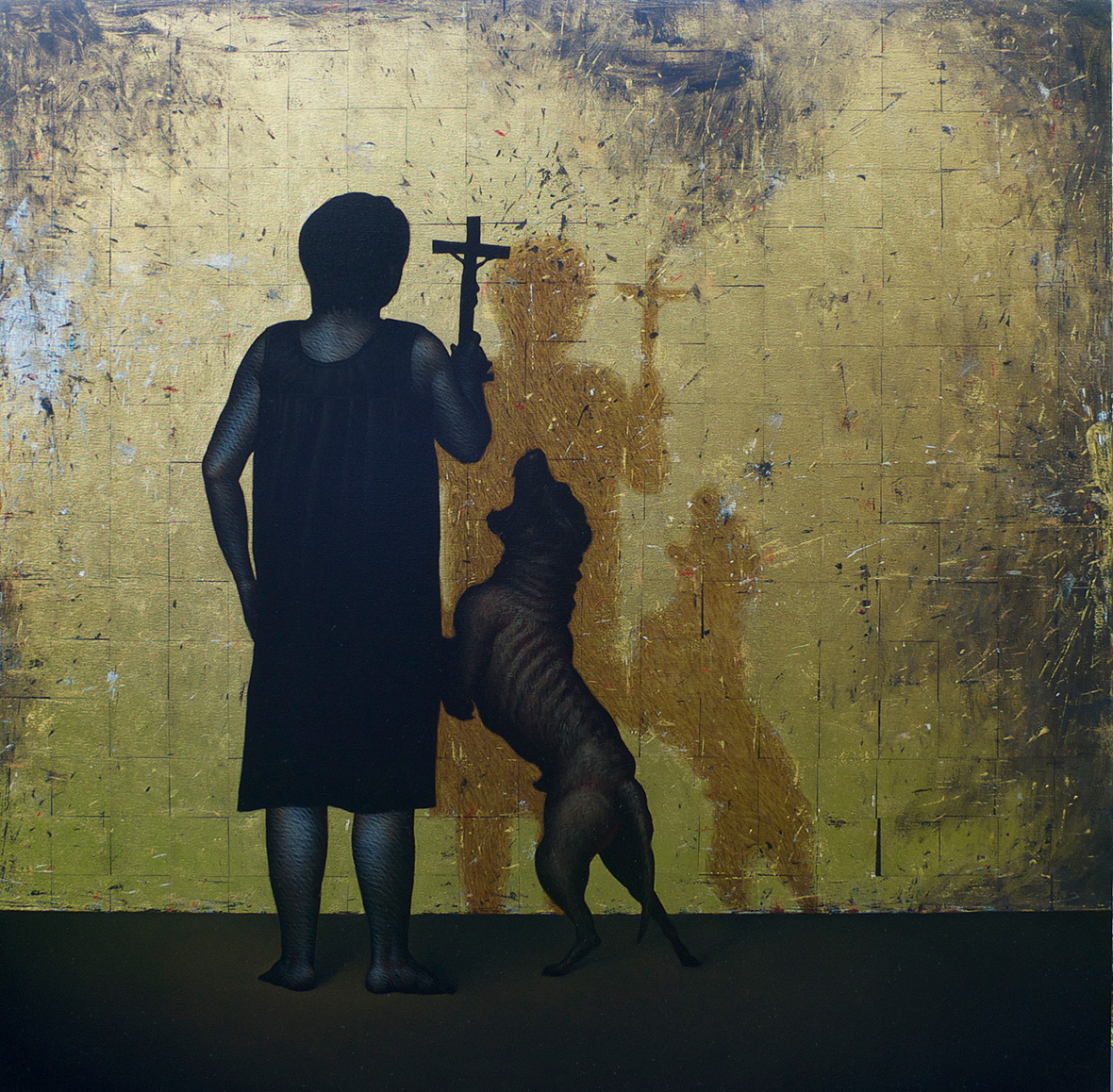
That appreciation for aged qualities can be also found in his characters’ skin; their dark, weathered complexions almost resemble the textures and depth of old stained glass. To achieve this, de Chavez uses a glazing technique where he starts with black-primed surfaces, building clear acrylic surfaces as he fills in the mid-tones, highlighting it all with whites on the uppermost layer. Against glittering gold leaf, the deep hues and rough features result in striking contrast. Although his depiction of dark skin is a result of technique, it’s a notable feature in a country where light skin is equated with beauty, where the top movie stars are often Eurasian and skin-whitening products fill entire supermarket aisles.
他喜欢厚重的历史感。这也体现在他笔下的人物皮上:饱经沧桑的黝黑肤色,充满着旧彩色玻璃的纹理质地和深邃感,这是 Leslie 运用罩染技巧做出来的效果。在黑漆背景之上,叠涂透明丙烯颜料,填充中间色调,最后在最上层用白色突显出来。深沉的色调和粗糙的纹理,与熠熠闪亮的金箔形成鲜明对比。这些黝黑皮肤固然是创作技巧所呈现的效果,但是却份外人注目,毕竟菲律宾是一个“以白为美”的国家,这里大多数电影大牌明星都是欧亚混血儿,美白产品摆满超市货架。
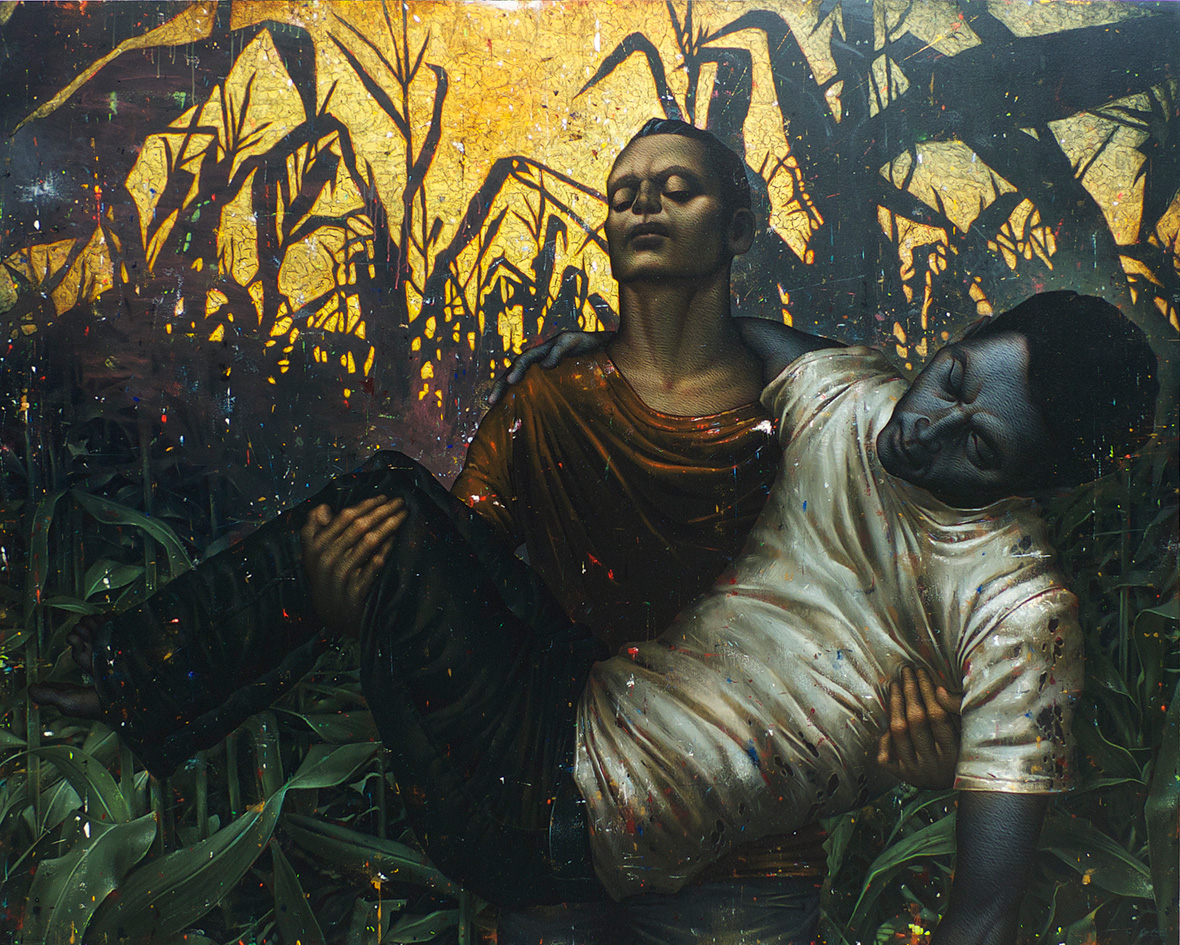
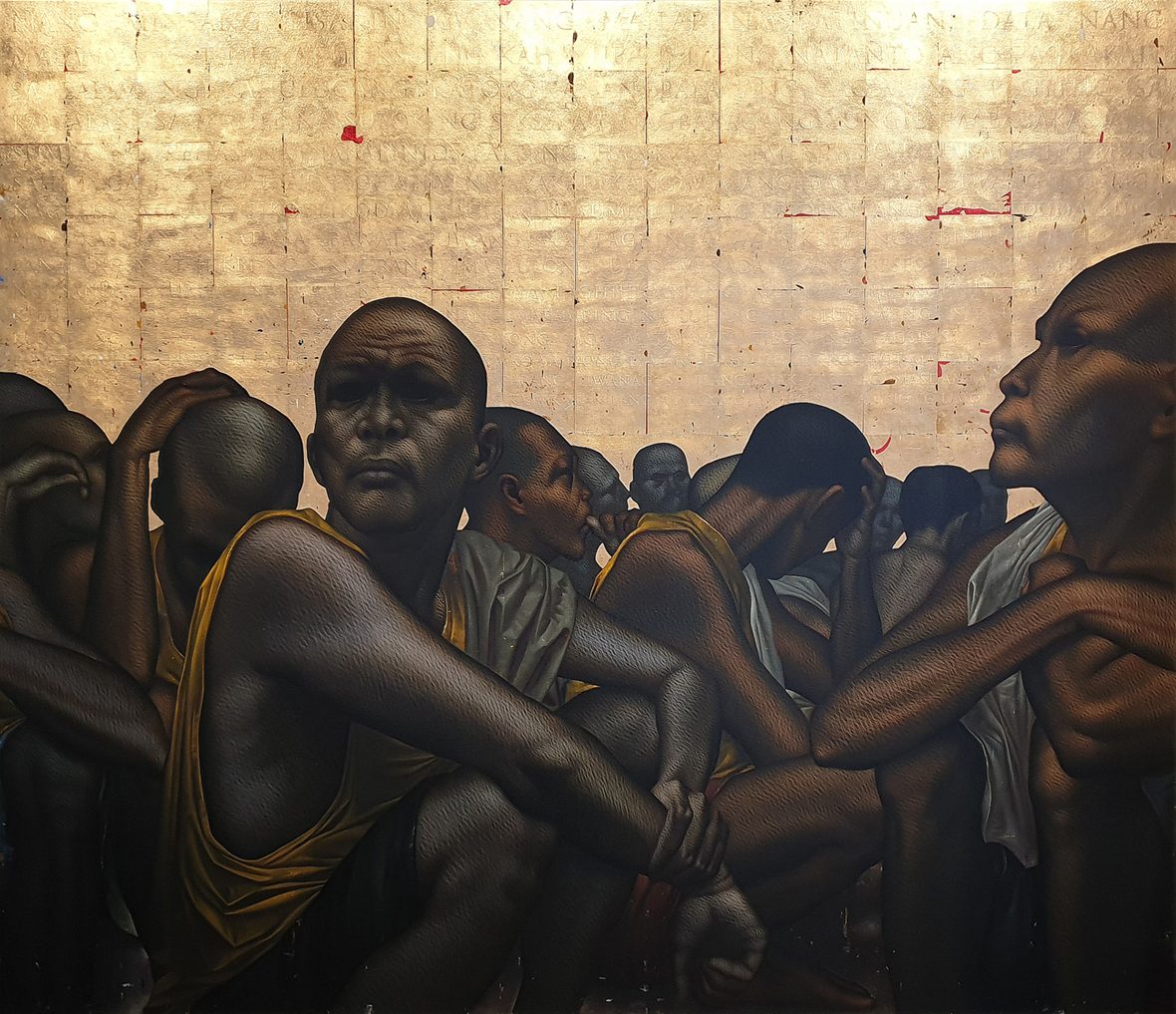
The people de Chavez chooses to paint are often the marginalized: farmers, prisoners, and the poor. Although the rough, neglected quality of their skin is primarily an aesthetic device, it can also be seen as core to the subject matter that his work revolves around—about the willingness and ability of the powerful to trample on the defenseless. In one piece, he tackles the plight of farmers, who are often killed in land and labor disputes. He paints a man carrying a dead friend through a cornfield; behind them, the sunset’s brilliance is shown with a dense arrangement of gold leaf. In another, he addresses the vast jail system, where overcrowding ranks among the world’s worst. Prisoners in his painting huddle together under heavily cast shadows that hide their eyes in dark hollows while gold shines overhead. In another, captors are forced to their knees, heads to the ground, and hands zip-tied behind them as soldiers loom ominously over them; the tightly cropped compositions leave little space for the walls of gridded gold leaf. Each scene is stark and jarring in their own way.
Leslie 画的通常都是社会的边缘人物:农民、囚犯和穷光蛋。这些人物粗糙的皮肤既是一种美学手段,但也可以看作是他作品主题的核心——当权者肆意地践踏毫无反抗之力的底层群体。在其中一幅作品中,他揭露了农民面临的一个困境:因土地和劳资纠纷而丧生。画中的一个男人正抱着死去的友人穿过玉米田,而在他们的身后,密密麻麻的金箔组成了夕阳的光辉。
在另一幅作品中,他揭露了监狱人满为患的情况,当地有着世界最严重的监狱过载问题。画中的囚犯挤在沉重的阴影下,空洞的黑暗淹没了他们的眼睛,而金色的光芒却在他们头顶照耀着。而还有一副作品里则画了这样的场景:俘虏被迫跪着,头抵着地面,双手被绑紧在背后,士兵的身影笼罩在他们身上;他的身影几乎占据了整个画面,剩余为数不多的空间则是用网格状金箔铺成的墙壁。Leslie 每一副画中场景都有着对比的鲜明,又令人震撼万分。
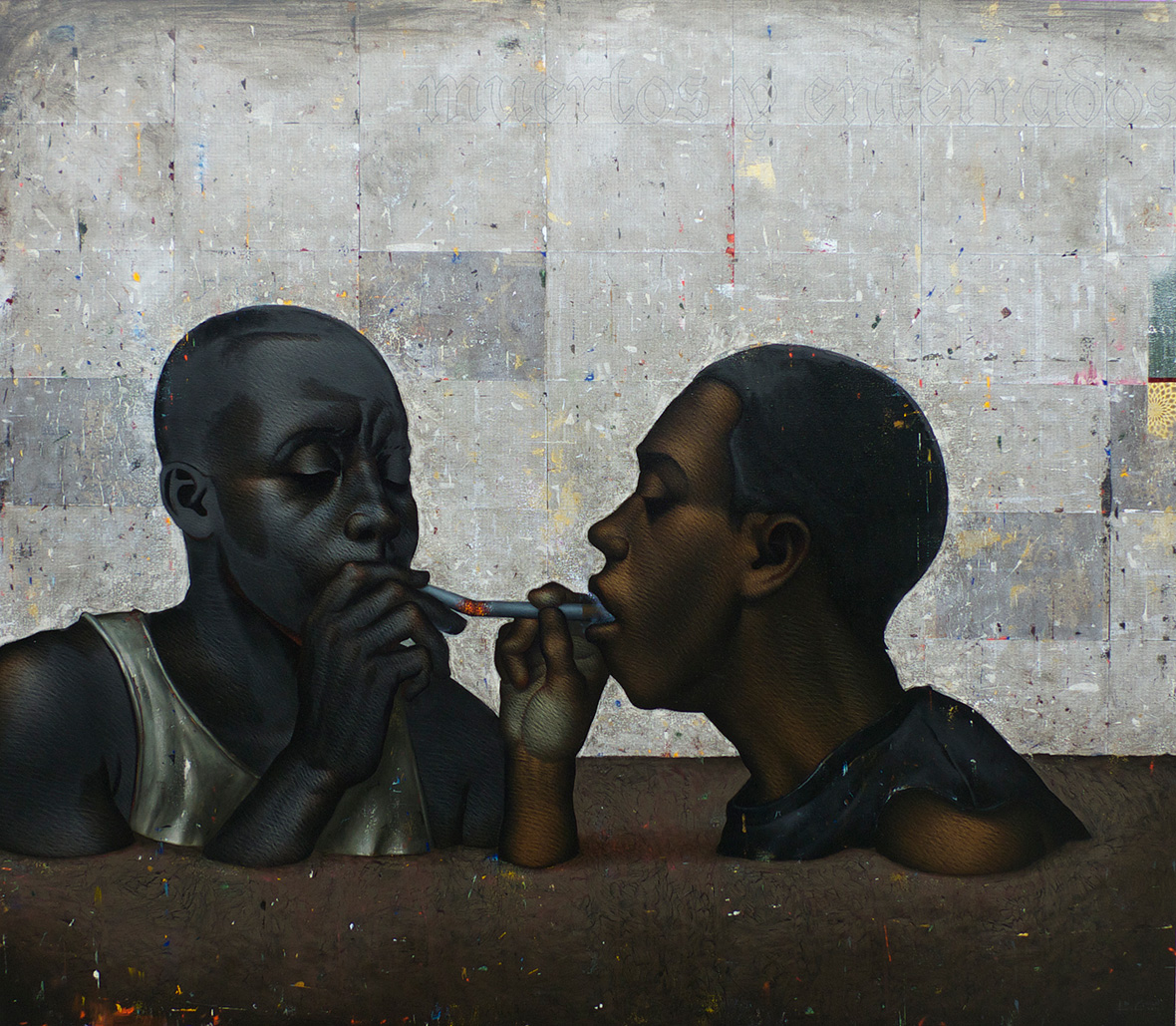
Another distinctive aspect of de Chavez’s art is that his characters’ eyes are always absent, either closed or missing entirely. This was designed to stress how dehumanizing imbalance of power can be. In his Dilim series the subjects’ faces are entirely covered by cloth, which speaks about wanting to escape into oblivion. It’s a reference to the poem Dilim, Mutyang Dilim by Alejandro Abadilla, which he interprets to be about that desire. The urge to disappear into the darkness and forget oneself is present in other pieces too, particularly The Escape To Being And Becoming, which depicts the fall into fatalism and passivity via two men, smoking cigarettes, half-submerged by the dirt ground. “They’re giving up their fate to the seemingly arbitrary laws of space and time,” he says, “instead, relying on a higher power such as religious or state figures.”
Leslie 作品的另一个特点是,总是看不到人物的眼睛,他们的眼睛要么闭着,要么消失不见,这样处理的目的是强调权力失衡所导致的人性丧失。在他的《Dilim》系列中,人物的面部完全被布覆盖,寓意逃避和遗忘,系列的名字引用自 Alejandro Abadilla 的诗《Dilim, Mutyang Dilim》,在他看来,这首诗讲述的正是这种逃避的愿望。在其他作品中也能找到这种要消失在黑暗中和忘掉自己的愿望,在其中一幅作品中,有两个在抽烟的男人,他们大半个身子淹没在泥土中,似是陷入了宿命论和消极的情绪中。他说:“他们放弃自己的命运,屈服于随意的时空定律,转而从宗教或伟人身上寻求依靠。”
de Chavez often responds to other works of art, building off them and extending their frame of reference to the Filipino experience. In When All Terms And Conditions Applied, he turns his gaze towards those in power. Two men embrace in a passionate kiss, a gun protrudes from one of their waists while a loaded wallet sticks out of the pocket of the other. The painting is a reference to the famous Fraternal Kiss piece painted on the Berlin Wall before its fall. He says this reimagining connects what’s happening in the Philippines to the rest of the world. The kiss is symbolic of a deal, one that benefits the powerful, sharing that power and its associated resources among themselves to the detriment of those outside their circles. “Power is equated with and assigned to the male ego,” he says. “This patriarchal and machismo attitude is hostile, deceitful, and arrogant.”
While the church still holds sway in the country, power is now wielded by many other forces. But as de Chavez’s work shows, its centuries of rule helped paved the way for a series of new actors to follow: those with their own interests at heart, not the peoples’.
Leslie 喜欢引用其他艺术作品,以这些作品为基础,加入菲律宾的体验重新演绎。在《When All Terms And Conditions Applied》中,他将目光转向当权者:两个男人正相互拥抱和深吻,其中一个人腰上别着一把枪,另一人的钱包则从口袋中伸出。这幅画的改编自柏林墙倒塌之前那幅著名的壁画《兄弟之吻》(Fraternal Kiss)。他说,这种重新构想能让菲律宾与世界联系起来。两个男人的亲吻象征着某种交易的达成以及当权者的获益。有权有势的人相互分享权力和资源,同时以损害其他人的利益作为代价。他说:“权力被赋予男性自我,两者划上了等号。这种家长式和大男子主义的态度充满敌意、欺骗性和自大狂妄。”
虽然在菲律宾,教会依然占主导力量,但现在有越来越多势力将其分权。但正如 Leslie 的作品所揭露的那样,宗教数百年的统治为一些当权者铺平了道路,但这些当权者只会关注自己的利益,绝非人民的利益。
Like our stories? Follow us on Facebook and Instagram.
Website: www.lesliedechavez.com
Contributor: Mike Steyels
Chinese Translation: Olivia Li

